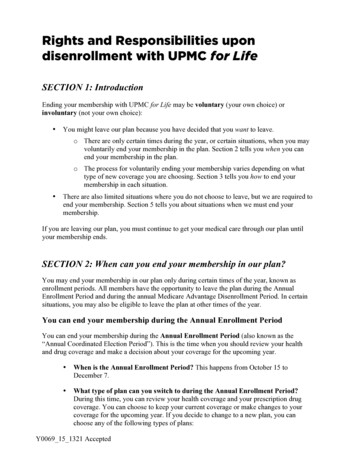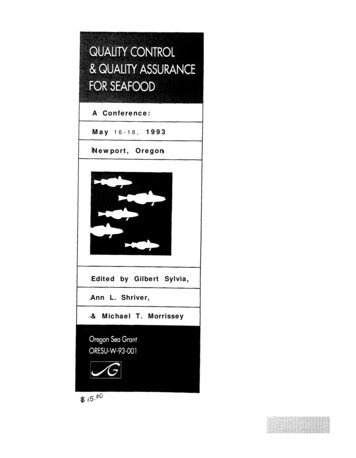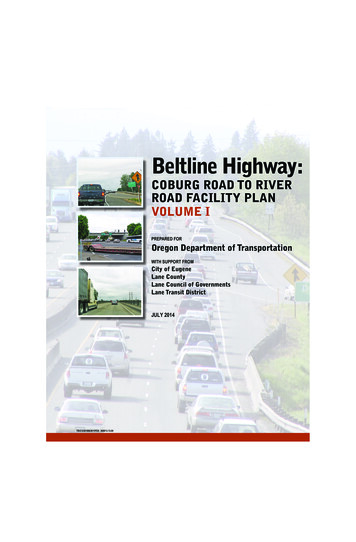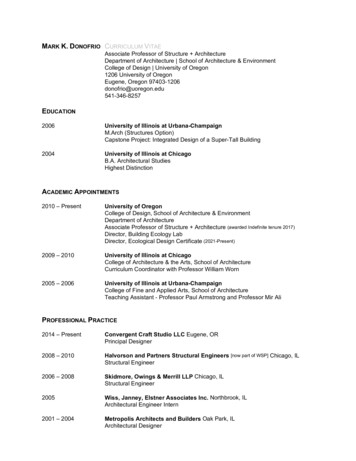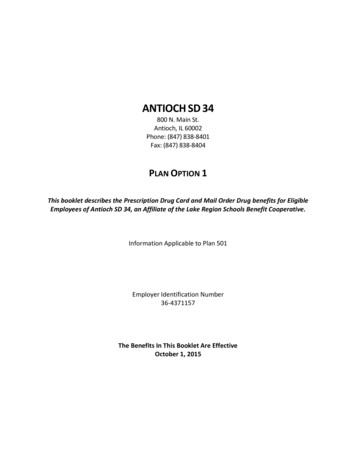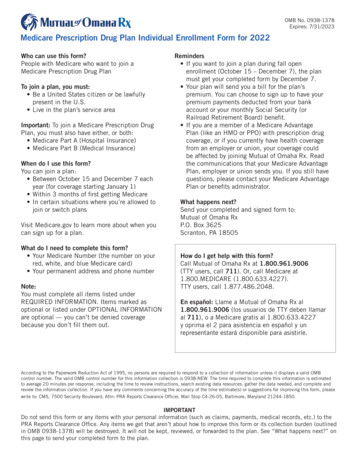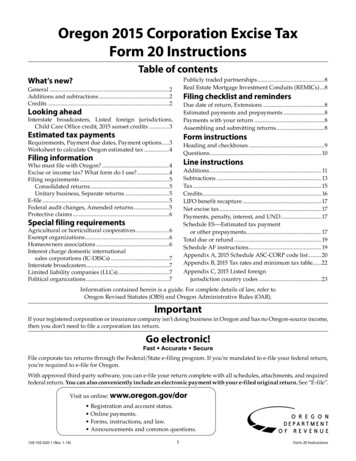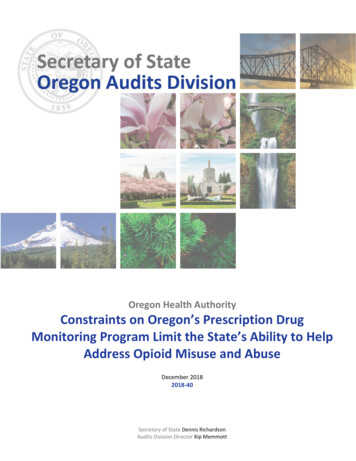
Transcription
Oregon Health AuthorityConstraints on Oregon’s Prescription DrugMonitoring Program Limit the State’s Ability to HelpAddress Opioid Misuse and AbuseDecember 20182018-40Secretary of State Dennis RichardsonAudits Division Director Kip Memmott
This page intentionally left blank
December 2018Oregon Health AuthorityConstraints on Oregon’s Prescription Drug Monitoring Program Limit theState’s Ability to Help Address Opioid Drug Misuse and AbuseReport HighlightsThe Prescription Drug Monitoring Program provides an important tool to address prescription drug abuse,including opioid abuse, and help improve health outcomes. Oregon’s laws have put constraints on the programthat limit its effectiveness and impact. Restrictions are placed on what data are collected, analyses that can bedone with the data, and with whom information can be shared. Correcting weaknesses in Oregon’s program willmaximize its potential and help address opioid and other substance abuse issues the state faces.BackgroundOregon has the highest rate in the nation of seniors hospitalized for opioid-related issues such as overdose,abuse, and dependence. The state also has the sixth highest percentage of teenage drug users. The OregonHealth Authority (OHA) manages the state’s Prescription Drug Monitoring Program (PDMP), which collectsinformation on controlled substance prescriptions within the state. The program was designed to promotepublic health and safety and to help improve patient care. It was also developed to support the appropriate useof prescription drugs.PurposeThe purpose of this audit was to determine if Oregon can better leverage its PDMP to help with the opioidepidemic.Key Findings1. OHA could better use PDMP data to analyze trends in prescribed drugs, including identifying patterns ofpossible opioid misuse and abuse. State laws prevent OHA from sharing information on questionableactivity with key stakeholders, such as health licensing boards and law enforcement. We found peoplewho received opioid prescriptions from excessive numbers of prescribers, as well as instances ofdangerous drug combinations and prescriptions for excessive drug dosages. One person who receivedan excessive amount of opioid prescriptions had some of those prescriptions paid for by Medicaid.2. Oregon is one of only nine states that does not require prescribers or pharmacies to use the PDMPdatabase before an opioid prescription is written or dispensed. Mandating use can be effective inreducing opioid misuse and other health related outcomes.3. Due to statutory restrictions, Oregon’s PDMP does not collect some prescription information that couldbe critical in preventing prescription drug abuse. This includes prescriptions filled by pharmacies otherthan only retail, veterinarian prescribed prescriptions, prescriptions for Schedule V drugs and drugsknown to be abused or misused such as gabapentin, and prescription details such as method ofpayment, lock-in status, and diagnosis information.RecommendationsOur report includes 12 recommendations to OHA for optimizing the state’s PDMP. OHA can implement some ofthese within existing statutes and rules, and for others it needs to work with the Legislature. OHA agreed withall of the recommendations, but stated that because seven fall outside the scope of its statutory authority, itsability to implement them is limited. The agency’s response can be found at the end of the report.
IntroductionOregon, like the rest of the nation, is in the midst of an opioid epidemic. The Governor declared apublic health emergency in March 2018 to address the opioid crisis as well as other substancemisuse and abuse challenges facing the state. 1 The Legislature, Oregon Health Authority (OHA),health-related boards, and communities have undertaken efforts to address the epidemic. Oneexample is the state’s Prescription Drug Monitoring Program (PDMP), which is managed byOHA’s Injury and Violence Prevention Program. The PDMP is a tool that tracks the dispensing ofprescription opioids and other medications of concern across the state. The purpose of this auditwas to determine how Oregon can better leverage its PDMP to help with the opioid epidemic.Oregon has an opioid crisis and one of the highest rates of prescription opioidmisuse in the nationMany substances can be misused or abused, but opioids are of particular concern due to thesignificant danger posed by their misuse. 2 While opioids can be helpful in addressing pain withappropriate medical oversight, they are highly addictive. Dependence on prescription opioidscan occur in less than a week, and taking a low dose prescription of an opioid for more thanthree months raises the risk of addiction 15-fold.Misuse occurs when a person takes a legal prescription medication for a purpose other than the reason it was prescribed, or whenthat person takes a drug not prescribed to them. Abuse occurs when a person takes a prescription medication to get a pleasant oreuphoric feeling.2 Opioids, a class of drugs derived from opium, were increasingly prescribed starting about 20 years ago and are still prescribed forpain management of conditions such as injury, surgery, cancer care, chronic conditions, and end-of-life care. Opioids range fromprescription pain relievers (e.g., oxycodone, hydrocodone, and morphine) to illegal substances (e.g., heroin). Opioids, natural orsynthetic chemicals, interact with opioid receptors on nerve cells in the body and brain. While plenty of opioid pain relievers aretaken safely as prescribed by a doctor, they carry the potential for abuse due to the euphoria that is often produced in addition topain relief.1Oregon Secretary of State 2018-40 December 2018 Page 1
People who develop a substance use disorder and need more of the drug, in addition to thosewho are cut off from their pain medications, may turn to illicit drugs, such as heroin andfentanyl. A study found frequent prescription opioid users and those diagnosed withdependence or abuse of prescription opioids are more likely to resort to heroin. 3Many people who are severely addicted end up incarcerated at some point. Nationally, it isestimated that almost 90% of those incarcerated with substance use disorders do not receiveaddiction treatment.Opioid and substance abuse is affecting Oregon’s youthOpioids and substance abuse are significantly impacting younger Oregonians. In 2016, almost500 pregnancies were complicated by maternal opioid use and 280 infants were born withNeonatal Abstinence Syndrome. 4 From 2015 to 2017, 314 more children entered foster care dueto a parent’s drug abuse.In Oregon and across the nation, there are also cases of young children accidentally ingestingopioid pain relievers. According to the National Poison Data System, pain medications were thethird most common substance involved in pediatric poisonings and were the most frequentsubstance involved in pediatric deaths from accidental ingestion in 2016. 5Most substance use disorders begin before or during adolescence.Nationally, Oregon has the sixth-highest percentage of teenagerswith a substance use disorder. In 2017, over a quarter of Oregoneighth graders and a third of eleventh graders said it was easy to getprescription drugs not prescribed to them. More than 60% of OregonYouth Authority adolescents have substance abuse or dependenceissues, or have parents that use alcohol or drugs. 657% of 12 to 17 year oldswho misusedprescription opioids gotthem from a friend orrelative.When it comes to providing access to treatment and recovery support for adolescents withsubstance use disorders, Oregon ranked nearly last (49th) nationwide.Opioid and substance abuse is impacting Oregon’s senior citizensOregon has the highest rate in the nation of seniors, categorized as those age 65 and older,hospitalized for opioid-related issues such as overdose, abuse, and dependence. Seniors’ longterm use of prescription opioids increases the likelihood of falls and fractures. The U.S.Department of Health & Human Services Office of Inspector General found that 32% ofOregonians with Medicare Part D prescription drug coverage received prescription opioids in2017. This figure was higher than 28 other states.When it comes to providing access to treatment and recovery support for those with substanceuse disorders, Oregon was ranked last (50th) for adults.Jones CM, Logan J, Gladden RM, Bohm MK. Vital signs: demographic and substance use trends among heroin users – United States,2002-2013. Morbidity and Mortality Weekly Report (MMWR). Atlanta, GA: Centers for Disease Control and Prevention; 2015.4 Neonatal Abstinence Syndrome is a group of problems that occur when newborns withdraw from addictive opioids they wereexposed to and became dependent upon while in the mother’s womb.5 David D. Gummin, James B. Mowry, Daniel A. Spyker, Daniel E. Brooks, Michael O. Fraser & William Banner (2017) 2016 AnnualReport of the American Association of Poison Control Centers’ National Poison Data System (NPDS): 34th Annual Report, ClinicalToxicology, 55:10, 1072-1254, DOI: 10.1080/15563650.2017.1388087.6 Oregon Youth Authority OYA Quick Facts January 2018.3Oregon Secretary of State 2018-40 December 2018 Page 2
Oregon ranks high for substance misuse and abuseThe national opioid crisis is estimated to cost hundreds of billions ofdollars a year, factoring in the costs of healthcare, social services,education, criminal justice, and employment and wage losses. Noeconomic class or locale is immune, and the impacts goes well beyondthe individual to affect other family members, particularly children,and communities.Americans consumemore opioids, includingprescription opioids,than any other country.Prescription opioid abuse is part of a broader drug abuse problem in the state. Oregonians suffermore from substance use disorders than those in most other states. Mental Health America, anational nonprofit that helps address the needs of those living with mental illness, rankedOregon as the state with the highest rate of mental health and substance use problems. Not onlydoes Oregon rank high in many concerning areas related to drugs and alcohol, as shown inFigure 1, it also ranks the highest in all measures compared to nearby states.Figure 1: Oregon consistently ranks high for drug misuse and abuse among nearby statesSubstanceUseDisorderIllicitDrug UseDisorderin thePast YearIllicit DrugUse OtherThanMarijuanain the PastMonthHeroinUse inthe PastYearAlcohol UseDisorder inthe PastYearNeeding But NotReceivingTreatment at aSpecialty Facilityfor Alcohol Use inthe Past YearNeeding But NotReceivingTreatment at aSpecialty Facilityfor Substance Usein the Past 6303025131318343943478363838PainRelieverMisuse inthe PastYearOregonStateCaliforniaSource: Substance Abuse and Mental Health Services Administration’s 2015-16 National Survey on Drug Use and Health. Survey includesthe fifty states and Washington D.C.Oregon has seen opioid overdose hospitalizations generally increase since 2000, which includesprescription and illicit opioids. The median cost is 13,000 for a hospitalization due to opioids,which lasts for two days on average. 7Prescription opioid painkillers contribute to a large portion of Oregon’sDeaths due todrug overdose deaths. Prescription opioid overdose deaths in Oregon haveprescriptiondecreased 45% since peaking in 2006, but are still higher than the earlyopioids equate to2000s, see Figure 2. Deaths due to prescription opioids have decreasedabout oneover recent years, but still equate to about one Oregonian dying everyOregonian dyingthree days. These numbers may be even higher, as researchers say 20% toevery three days.35% of opioid-related overdose deaths are undercounted in the nation.Decreases in opioid overdoses are likely partially attributable to theincreased availability and use of naloxone, a medication that reverses the effect of an opioidoverdose and is increasingly being carried by law enforcement and first responders.7OHA’s Opioid Overdose in Oregon Report to the Legislature, September 2018.Oregon Secretary of State 2018-40 December 2018 Page 3
Figure 2: Accidental opioid overdose deaths in Oregon have declined, but are still higher than early 2000ratesRate per 100,000 Population765432102000 2001 2002 2003 2004 2005 2006 2007 2008 2009 2010 2011 2012 2013 2014 2015 2016Note: The category ‘prescription opioids’ includes deaths due to natural and semi-synthetic opioids, methadone, and synthetic opioidsother than methadone and does not differentiate between illicit vs. legal.Source: Oregon Health Authority’s Opioid Overdose in Oregon Report to the Legislature September 2018.Oregon has been working to address its opioid crisisThough addiction and substance abuse were declared a public health crisis in Oregon by theGovernor in March 2018, there have been previous efforts in Oregon to try to curb the state’sopioid epidemic. Some of the key efforts can be seen in Figure 3.To help with the high costs of dealing with opioid abuse, Oregon, along with other states andcounties, has filed lawsuits against drug companies to hold them responsible for misleadingclaims on the harm of opioid medications. Settlement funds have been allocated toward effortssuch as increasing opioid addiction services, implementing best practices in pain management,and expanding outreach and educational components of treatment programs.Reducing the amount of unwanted and unused pills helps to reduce the risk of abuse. Oregondoes not have a coordinated, statewide drug take-back program intended to reduce the numberof pills in circulation. There are collection sites in multiple locations across the state fordisposing of unused opioid and other prescription drugs, located in some pharmacies and atmost police stations. Additionally, there are nationally coordinated drug take-back days heldtwice yearly.Oregon has made progress in dispensing fewer opioidprescriptions over recent years. This may be from guidelinesto help curb overprescribing, and state and national efforts toeducate doctors. Even so, Oregon is still prescribing opioids ata rate of 13% more than the national average, and the U.S.prescribes more than other comparable countries. Accordingto the 2019 drug threat assessment by the Oregon-Idaho HighIntensity Drug Trafficking Area program, the availability andmisuse of prescription drugs remain at a high level eventhough some indicators suggest a recent decline in misuse. 8OHA reported approximately 7million prescriptions forcontrolled substances (e.g.,opioids, Attention DeficitHyperactivity Disordermedications, and sedatives) weredispensed annually forOregonians. Over half of thesewere opioids, with hydrocodonebeing the most common.8 The Oregon-Idaho High Intensity Drug Trafficking Area program was established by the White House Office of National DrugControl Policy in June 1999. It consists of 14 counties and the Warm Springs Indian Reservation. Counties in Oregon includeClackamas, Deschutes, Douglas, Jackson, Lane, Linn, Malheur, Marion, Multnomah, Umatilla, and Washington counties.Oregon Secretary of State 2018-40 December 2018 Page 4
Figure 3: Timeline of some key efforts taken to address opioid issues in OregonPrescription drug monitoring programs are state-level tools to improve opioidprescribing, inform clinical practice, and protect patientsAll fifty states have prescription drug monitoring programs (PDMPs), with program data used ina variety of ways to address the opioid epidemic and substance abuse issues. 9 PDMPs maintainan electronic database of prescription information collected directly from pharmacies in anMissouri is the only state without a statewide prescription drug monitoring program. However, within Missouri, St. Louis Countystarted its own PDMP in April 2017 and more than 80% of Missouri doctors and pharmacists participate on a voluntary basis.9Oregon Secretary of State 2018-40 December 2018 Page 5
effort to provide physicians and pharmacists with critical information regarding a patient’sprescription history. These databases also allow state tracking of physician prescribing practicesto inform guidelines and efforts to improve addiction prevention and treatment.All PDMPs, at a minimum, collect prescription information on drugs federally classified ascontrolled substances per Schedule II, III, and IV; see Figure 4. Most states go further and collectinformation on Schedule V substances. Oregon is not among them.Figure 4: The Controlled Substances Act has divided drugs and other substances considered controlledsubstances into five schedulesSchedule ISchedule IISchedule IIISchedule IVSchedule VPotential for AbuseDescriptionExamplesHighSubstances with no currently acceptedmedical use in the U.S., and a lack ofaccepted safety for use under medicalsupervision, and are therefore neverprescribedLSD, heroin, marijuana, and peyoteHighSubstances that have a high potentialfor abuse, which may lead to severepsychological or physical dependenceOxycodone (OxyContin , Percocet ),methadone (Dolophine ), fentanyl,morphine, codeine, amphetamine(Dexedrine , Adderall ),methamphetamine (Desoxyn ),methylphenidate (Ritalin ), andpentobarbitalModerateSubstances that have a potential forabuse less than Schedule I or IIsubstances, and abuse may lead tomoderate or low physical dependenceor high psychological dependenceBuprenorphine (Suboxone ), productswith no more than 90 milligrams ofcodeine per dosage unit (Tylenol withCodeine ), benzphetamine (Didrex ),ketamine, and anabolic steroids(Depo -Testosterone)LowSubstances that have a low potentialfor abuse relative to Schedule IIIsubstancesAlprazolam (Xanax ), carisoprodol(Soma ), clonazepam (Klonopin ),diazepam (Valium ), and temazepam(Restoril )Substances that have a low potentialfor abuse relative to Schedule IVsubstancesEzogabine, lacosamide, and pregabalin(Lyrica )LowSource: U.S. Department of Justice Drug Enforcement AdministrationOregon’s PDMP was created to help with patient health and safety when using controlledsubstancesThe Oregon PDMP, enacted in 2009, started collecting prescription information in late 2011,making it among the last dozen of states to implement a PDMP. Oregon designed the program topromote public health and safety and help improve patient care by providing healthcareprescribers and pharmacists with information to better manage patients’ prescriptions. It wasalso developed to support the appropriate use of prescription drugs.Over the last few years, state legislation has allowed the program to expand the informationcollected and those who can access that information; see Figure 5.Oregon Secretary of State 2018-40 December 2018 Page 6
Figure 5: Timeline of the key legislative changes to Oregon’s PDMPPDMP information collected inOregonPatient receiving the prescription(name, DOB, address, sex, andphone number)Prescriber (name and DEA number)Date medication prescribedPrescription numberPharmacy DEA numberDate medication dispensedDrug prescribed (name, nationaldrug code number, quantity, days’supply, and number of refills)Like many other states, Oregon’s PDMP collects informationon controlled substance prescriptions dispensed from statelicensed retail pharmacies to its residents. Retailpharmacies are required to report the prescriptioninformation to the PDMP within 72 hours. Prescriptionscollected in Oregon are for Schedule II, III, and IV controlledsubstances, pseudoephedrine, and, starting in 2018,naloxone. 10 The PDMP database maintains prescriptioninformation for three years that is accessible to authorizedusers. Besides system users, others can receive some PDMPdata. For example, patients may request a copy of their ownprescription information and, under certain circumstances,law enforcement and licensing boards may request PDMPdata. Researchers may be granted de-identified data forapproved studies.An advisory commission is charged with studying issues related to the PDMP, makingrecommendations to OHA for operating the PDMP, and developing criteria to evaluate programdata. In January 2018, the Clinical Review Subcommittee was formed that uses PDMP10Pseudoephedrine is used for the temporary relief of stuffy nose and sinus pain.Oregon Secretary of State 2018-40 December 2018 Page 7
information to identify healthcare prescribers who should receive education or training onprescribing opioids.OHA administers Oregon’s PDMPOregon’s PDMP is housed within the Office of Injury and Violence Prevention Program, locatedwithin the Public Health Division of OHA. OHA has an opioid initiative to reduce deaths, non-fataloverdoses, and harm to Oregonians from prescription opioids, while expanding use of nonopioid care.Since 2011, PDMP personnel have typically consisted of a manager and four staff. Staff registerusers, perform some quality assurance and analysis, and coordinate efforts with the advisorycommission, boards, and other health entities.Figure 6: Oregon’s organization of its PDMP is similar to nearby statesStateFull Time Equivalent (FTE) StaffAgency TypeNumber of Prescribers4Department of Health24,000California11 Law Enforcement188,000Colorado0-1Board of Pharmacy31,000Idaho2-5Board of Pharmacy8,000Nevada2-5Board of Pharmacy12,000Washington11 Department of Health44,000OregonSource: Prescription Drug Monitoring Program Training and Technical Assistance Center, Brandeis University. Some states have additionalresponsibilities within their program that others do not.The PDMP contracts with a vendor to maintain the database of prescription information. Oregonuses the same vendor for its PDMP that 42 other states and territories use for theirs.OHA does not receive state funding for operating Oregon’s PDMP. Rather, it is funded throughlicensing fees. This is similar to California and 20 other states. 11 Having a stable funding source,like licensing fees, is considered a leading practice among PDMPs. All Oregon-licensed healthcareprescribers and pharmacists pay a 25 annual fee included in their board licensing fees. For tworecent fiscal years, 2017 and 2018, funding for the program totaled approximately 1.6 million.11 Other primary funding sources for states’ PDMPs come from federal grants (e.g., Washington and Nebraska), regulatory boardfunds (e.g., Kansas and South Dakota), and other funding such as health insurance licensing fees (e.g., New York) and legalsettlements (e.g., Virginia).Oregon Secretary of State 2018-40 December 2018 Page 8
Objective, Scope, and MethodologyObjectiveOur audit objective was to determine if Oregon can better leverage its PDMP to help with theopioid epidemic.ScopeThe audit covers PDMP efforts since its inception, and program data for calendar years 2015through the first quarter of 2018.MethodologyTo address our objective, we conducted interviews with multiple stakeholders, including PDMPstaff, OHA personnel, members of the Legislature, members of the PDMP Advisory Commission,members of licensing boards (the Board of Pharmacy, the Board of Optometry, the OregonMedical Board, the Board of Dentistry, the Board of Naturopathic Medicine, and the Board ofNursing), representatives of the Oregon Medical Association and Oregon Society of HealthSystem Pharmacists, staff of other government agencies, other states’ PDMP staff, practicingprescribers and dispensers, staff from the Oregon Pain Commission, and staff from Lines forLife. 12We reviewed state laws and administrative rules related to the program and our audit objective.We also reviewed the program’s quarterly and annual reports, Oregon PDMP user surveysconducted by OHA, as well as the website materials relevant to our audit objective. We alsoreviewed the program’s policies and procedures.We identified leading practices for PDMPs through a review of materials from the PrescriptionDrug Monitoring Program Training and Technical Assistance Center at Brandeis University,materials from the Substance Abuse and Mental Health Services Administration Center, theNational Governor’s Association, the National Alliance for Model State Drug Laws, and academicresearch studies through various medical publications.We obtained PDMP data from the Oregon Health Authority and performed limited datareliability testing and analyzed data to identify questionable activity such doctor shopping andprescriptions for risky drug combinations. 13 We performed testing to determine thecompleteness of the data with other state prescription claims datasets. We obtained Medicaidpharmacy claims and Oregon Prescription Drug Program data from OHA. We also obtainedWorkers’ Compensation pharmacy claims data from the State Accident Insurance FundCorporation (SAIF), Oregon’s nonprofit workers’ compensation insurance company. All data setscovered calendar years 2015 through 2017.We reached out to the U.S. Department of Treasury to gain access to the Social SecurityAdministration’s Death Master File to look for potentially inappropriate payment of prescriptiondrugs (e.g., prescriptions recorded as written by deceased prescribers and prescriptionsdispensed to deceased recipients) but we were unable to gain access in time to perform testing.We conducted this performance audit in accordance with generally accepted governmentauditing standards. Those standards require that we plan and perform the audit to obtainLines for Life is a nonprofit organization that manages crisis lines and programs to help prevent substance abuse and suicide.Doctor shopping occurs when a patient receives controlled substance prescriptions from multiple healthcare prescribers withoutthe prescribers’ knowledge of the other prescriptions.1213Oregon Secretary of State 2018-40 December 2018 Page 9
sufficient, appropriate evidence to provide a reasonable basis for our findings and conclusionsbased on our audit objective. We believe that the evidence obtained provides a reasonable basisfor our findings and conclusions based on our audit objective.We sincerely appreciate the courtesies and cooperation extended by officials and employees ofthe Oregon Health Authority and SAIF during the course of this audit.Oregon Secretary of State 2018-40 December 2018 Page 10
Audit ResultsOregon deliberated through multiple legislative sessions to establish its PDMP and designed thistool to focus on helping with patient health and safety. For the seven years it has been operating,Oregon’s PDMP has been voluntary, informational, and educational for medical professionals. InMarch 2018, the Governor declared a public health emergency around addiction, responding toOregon’s challenges in combating substance use disorders.A PDMP is not the sole solution to the opioid crisis or other drug misuse and abuse, but it is a keytool that can help in combating drug epidemics. Following the example set by other states,Oregon can take more robust action to optimize its PDMP. The limited scope of Oregon’s PDMPis due mainly to constraints put on the program by the Legislature. These limit the PDMP’sefficiency, effectiveness, and impact. Correcting limitations in Oregon’s PDMP will maximize itspotential to help address opioid and other substance abuse issues in the state.Our recommendations to OHA detail processes that can be implemented in the short term, aswell as recommendations to work with the Legislature on statutory changes. We believe some ofthese processes can be implemented using existing resources and therefore would not requirean increase in the program fee healthcare licensees pay. There is also the potential for reducingdrug and medical costs within Medicaid by implementing recommendations that focus on bettermonitoring of patients’ prescriptions.PDMP data shows questionable activity has been occurring for years, butstate laws limit OHA’s ability to investigate and mitigate such activityPDMPs are a great source of information that could be better used to delve into prescribing anddispensing practices. OHA has started to use PDMP data to examine questionable practices, butlittle action has been taken to address the concerns. State laws limit the examination ofpractitioners’ activities and do not allow analyses focused on patients. 14 More robust analysesabout the nature and extent of prescribing and dispensing practices would better informdecision-making about substance abuse in Oregon.Oregon’s PDMP does some prescribing analysis, but more can be doneFor the past seven years, Oregon’s PDMP has focused its data analyses on overall prescriptiontrends, the most frequently prescribed drugs, prescriptions related to the treatment ofsubstance use disorders, and the use of the PDMP database by healthcare prescribers andpharmacists. These analyses are completed on a monthly and quarterly basis, and PDMPproduces an annual report for its program’s advisory committee. The PDMP has also contributeddata to OHA’s prescribing and drug overdose data dashboard, which is an interactive tool thatcontains state and county level data on controlled substance prescribing and drug overdosehealth outcomes.While OHA is performing some analyses at the county and state level, these metrics are typicallysiloed and not layered together for patterns. A promising practice for PDMPs is to use data toidentify hot spots, or areas likely to see higher rates of opioid hospitalizations or overdosedeaths. By identifying hot spots within Oregon, OHA could better help municipalities target theirlimited prevention and intervention resources.Looking at high-level prescribing trends is valuable, yet PDMP data can be better leveraged toidentify patterns of possible opioid misuse and abuse. Behaviors like doctor shopping and over14ORS 431A.850-900 and OAR 333-23.Oregon Secretary of State 2018-40 December 2018 Page 11
prescribing are often associated with increases in opioid misuse and overdose. Examples ofpossible patterns include:
The Prescription Drug Monitoring Program provides an important tool to address prescription drug abuse, including opioid abuse, and help improve health outcomes . Oregon's laws have put constraints on th e program . maximize its potential and help address opioid and other substance abuse issues the state faces. Background.
